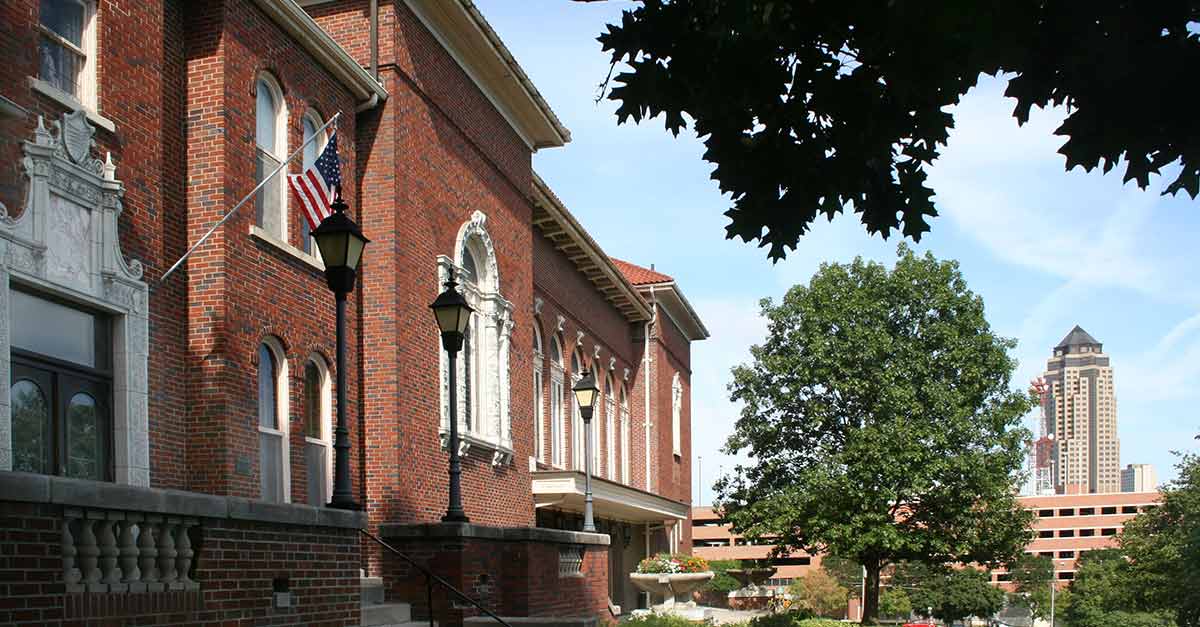How Hoyt Sherman Place Became a Landmark of Downtown DSM

A Storied History
Hoyt Sherman was born in Lancaster, Ohio, in 1827 as the youngest child in a family of six boys and five girls. His father had big dreams for his children and encouraged them to pursue politics, military service and business/finance. Noteworthy family members include older brothers, John Sherman, the writer of Sherman Anti-Trust Act, and Civil War General, William Tecumseh Sherman, who led his soldiers through Georgia on the well-known “March to the Sea”. At the urging of his older brother, Hoyt was appointed by President Lincoln to serve as paymaster for the Union forces.
In 1848, Hoyt arrived in Greater Des Moines (DSM) ready to make his mark on the world. At that time, the city’s population was 127 residents. Hoyt passed the bar in 1849 and began to take on additional responsibilities and positions within the community. He was appointed as Postmaster and was also involved in building the first and second post office buildings as well as the first bank, street railway, public school, college and waterworks. He also had a hand in creating the first life insurance company west of the Mississippi River.
Having invested so much of his professional self in the community, Hoyt was now looking to invest in some land, which would later become a home for himself, his wife Sara, and their five children. In 1850, he purchased a parcel of land located at the intersection of 15th Street and Woodland Avenue – where Hoyt Sherman Place still stands today. He paid $105 for 5 acres at the Hugh Pursley estate auction, but he would not end up using this land until much later in life.
In 1877, Hoyt was finally ready to build his mansion, which soon became known as a “society showplace on the grandest scale”. He invited many guests to this home including Generals Sherman, Grant, Sheridan and Major McKinley.
The Future of the Estate
After Hoyt’s passing in 1904, his estate, which was valued at $400,000, transferred to his five children, but none of the children were interested in taking possession of the property. They transferred the property by quit claim deed to the City of Des Moines with the caveat that it forever be called Hoyt Sherman Place.
Meanwhile, the Des Moines Women’s Club, founded in 1885, was looking for a clubhouse and approached the City about taking possession of Hoyt Sherman Place. The City agreed to rent the home to the Des Moines Women’s Club for $1 per year and in 1907, their first order of business was to build an addition onto the home to hold an art collection. This was the first public art gallery in DSM and remains open to this day.
The Des Moines Women’s Club was growing rapidly at this time and was eager to build a second addition onto the facility so they would have enough room for all of their current members to gather at once. However, their plans had to be put on hold due to the declaration of World War I. Finally, in 1922, ten years after the initial plans had been drawn up, construction began on a 1,400-seat theater as well as an expansion to the existing art gallery. The ladies of the Club were eager to show off their new theater when it was completed in 1923 and went on to schedule appearances by many notable figures of the time including Helen Keller, Will Rogers, John Philip Sousa, Amelia Earhart, Grant Wood and many more.
Hoyt Sherman Place Today
Today, almost 100 years after the theater was originally constructed, Hoyt Sherman Place is still the cornerstone of the Sherman Hill Neighborhood and still brings many speakers and notable performers of all genres to the stage. Most recently, we have welcomed country artist Wynonna Judd, classis rock band Kansas, comedian John Mulaney and radio personality Ira Glass. And, Hoyt Sherman Place is still a gathering place for the Des Moines Women’s Club, the Sherman Hill Neighborhood Association and many other community clients — a legacy of which the original members of the Des Moines Women’s Club and Hoyt himself would be proud.
Sherman Hill’s recent renaissance has solidified its reputation for being an artsy destination. To learn more about Downtown DSM’s neighborhoods, click here.